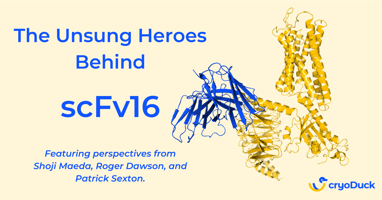I was recently a panelist at the 31st Protein Structure Determination in Industry Meeting (PSDI...
Transitioning from academia to a cryo-EM career in industry
Engaging in conversations with students, postdocs, and cryo-EM facility managers, I'm frequently asked whether transitioning to industry is a viable option. This question is individual and can't be universally answered. If you're persistently mulling over such thoughts, you likely already hold some inklings of your desired path. Personally, I find resonance with Isaiah Hankel, founder of Cheeky Scientist, who posits that academia often lacks a long-term perspective. I also agree with how forcefully he makes his points because you can be tunnel-visioned when you're drifting in academia. I certainly catch myself wanting to have a word with my younger self as someone who is guilty of that. However, it's worth remembering that years which may not bolster your CV could still be amongst your most fulfilling, and certain unique aspects of cryo-EM in industry should be understood to make well-informed decisions. This post aims to offer a foundational guide for those who aren't necessarily seeking a career pivot — often promoted by the Cheeky Scientist, which might lead you away from cryo-EM — but are instead considering a career transition within a field that is hard to leave behind.

Navigating the Career Spectrum
A binary view of academia versus industry oversimplifies a much more complex reality. Within academia, roles vary with individuals choosing paths as group leaders and principal investigators (PIs), while others prefer roles as research scientists within research groups or core facilities. The emphasis on whether you identify as a cryo-EM expert, a structural biologist, or a molecular biologist can vary greatly, as can your preference for applied or basic research, all of which play key roles in shaping your industrial appeal.
The industrial landscape is even more diverse. Cryo-EM opportunities abound not only in pharmaceutical and biotech companies, but also in contract research organizations (CROs), known for providing cryo-EM services, and solution providers that specialize in areas such as microscope development, sample preparation, or software engineering. Each of these entities offers roles where you can apply your expertise as an application scientist who conducts cryo-EM. Such roles present a natural transition from your current work. Before delving into the differences in environment and additional roles in industry — which I'll explore in future posts — I'd like to highlight a few subtle yet significant factors you should consider.
Understanding the Shift in Social Currency and Status
Transitioning from academia to industry may not always present an upward trajectory in social standing, especially within the realm of structural biology. In academia, structural biology groups often hold high status due to their ability to secure significant biomedical grants and generate high-impact publications, both contributing to the group's and the affiliated institution's reputation.
However, in pharmaceuticals and biotech, structural biology and structure generation may play more supplementary roles, often regarded as 'nice-to-haves' rather than mission-critical. Consequently, structural biology teams might find themselves lower in the pecking order, particularly when compared to teams directly driving drug development or market-oriented research. This disparity in status may result in a perceived drop in standing for academics transitioning to industry, a factor worth considering in your career decision-making process.
Furthermore, in academia your currency extends beyond the financial to the reputational. As an academic, you hold a unique position of esteem built on the respect garnered through your research and development efforts. This societal recognition forms an integral part of your academic social currency, adding to your esteem and prestige not just among your academic peers, but in the broader societal context as well. It's this extended sphere of influence that further elevates the rewarding nature of academia, providing a sense of value and fulfillment that goes beyond monetary gains and professional accolades.
Recognizing Geographical Limitations
It's also worth noting the geographical limitations of industrial cryo-EM. While academic cryo-EM has found its way to every corner of the world, its industrial counterpart is largely concentrated within a few key hubs. In the United States, the Boston and New England area, as well as San Francisco, are significant cryo-EM centers. In the United Kingdom, Cambridge and Oxford stand out, while Basel in Switzerland and a few areas in the Rhine-Main valley spanning Germany and France also host notable clusters.
These geographical imbalances are largely due to the concentration of biotech and pharmaceutical industries in these regions. These sectors have a particularly strong presence in the US, where an open-minded culture and the availability of significant funding have cultivated a fertile ground for cryo-EM to flourish.
Europe and China, on the other hand, are home to a slightly higher number of contract research organizations (CROs) engaged in cryo-EM work. The lower operating costs in these regions make them attractive locations for such organizations, which offer cryo-EM services to other companies.
The implication of these geographical disparities is that a move to industrial cryo-EM might also entail relocation, depending on your current location and willingness to move. This is another factor to consider when contemplating the transition from academia to industry, particularly for those who have strong feelings about not wanting to live in the US.
Preparing for Greener Pastures
Despite some of the considerations and challenges mentioned, a career in industry still offers the best long-term prospects for many, and is teeming with opportunities to be involved in world-class science. The pace can be exhilarating, the projects groundbreaking, and the opportunities for advancement abundant. If your passion lies in translating scientific discoveries into real-world applications, a career in industry could offer immense satisfaction.
However, to make a well-informed decision about your career trajectory, it is advisable to establish industry ties while you're still within academia. Building these relationships will offer you a firsthand perspective on the industrial landscape, its challenges, and opportunities. Prove yourself to be a dependable partner, engage in cutting-edge work, and always be open and forthcoming. Cultivate a mindset that reduces bureaucratic red tape and propels you to apply yourself with urgency and a solution-oriented attitude.
Your efforts will not go unnoticed. Colleagues and potential employers will appreciate your industriousness, your commitment to excellence, and your aptitude for collaborative problem solving. As you continue to demonstrate these traits, you'll find that opportunities start to present themselves. People will enjoy working with you, and before you know it, they may even start inviting you to join their teams.




